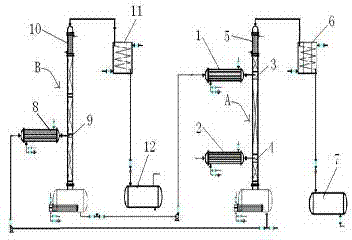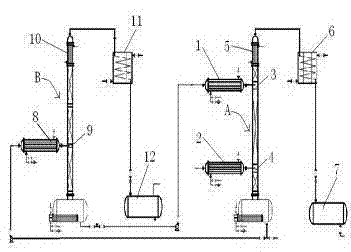Method for recycling solvent, namely isopropanol, during production of carvone
A technology of recovery and treatment of isopropanol, which is applied in chemical instruments and methods, preparation of organic compounds, organic chemistry, etc., can solve problems such as inability to produce carvone, unfavorable industrial production, long production cycle, etc., and achieve enhanced international Market competitiveness, cost saving, less side effects
- Summary
- Abstract
- Description
- Claims
- Application Information
AI Technical Summary
Problems solved by technology
Method used
Image
Examples
Embodiment 1
[0020] Take the theoretical plate number of the extractive distillation column as 70 (the plate number is counted from bottom to top), select the ethylene glycol mixed solution containing potassium acetate mass fraction as 20% as the salt-added extraction agent, and start from the 65th theoretical plate Add, flow rate is 1500kg / hour, water content is the isopropanol aqueous solution of 15% to add from the 20th theoretical plate, flow rate is 500 kg / hour. Operate under normal pressure, the reflux ratio at the top of the tower is 0.3, the temperature at the top of the tower is controlled at 82-83°C, and the temperature at the bottom of the tower is controlled at 130-135°C. Analyze the isopropanol that tower top obtains, water content is 5%.
[0021] The water, salt, and solvent mixture in the tower kettle enter the regeneration tower. In this embodiment, the regeneration tower selects 50 theoretical plates, the feeding position is the 20th theoretical plate, and the operating ...
Embodiment 2
[0023] The number of theoretical plates of the extractive distillation column is selected as 80 (the number of plates is counted from bottom to top), and the ethylene glycol mixture containing sodium acetate with a mass fraction of 15% is selected as the salt-added extraction agent. From the 72nd theoretical plate Adding, the flow rate is 1300kg / hour, and the isopropanol solution with a water content of 14% is added from the 20th theoretical plate, and the flow rate is 500 kg / hour. Operate under normal pressure, the reflux ratio at the top of the tower is 0.5, the temperature at the top of the tower is controlled at 82-83°C, and the temperature at the bottom of the tower is controlled at 130-135°C. The isopropanol obtained at the top of the tower is analyzed with a water content of 0.4%.
[0024] The water, salt, and solvent mixture in the tower kettle enter the regeneration tower. In this embodiment, the regeneration tower uses 40 theoretical plates, the feed position is at th...
Embodiment 3
[0026] The number of theoretical plates of the extractive distillation column is 90 (the number of plates is counted from the bottom to the top), and the propylene glycol mixture containing sodium propionate with a mass fraction of 18% is selected as the salt-added extraction agent, and the salt is added from the 79th theoretical plate. , the flow rate is 1300 kg / hour, and the isopropanol solution with a water content of 13% is added from the 20th theoretical plate, and the flow rate is 500 kg / hour. Operate under normal pressure, the reflux ratio at the top of the tower is 0.6, the temperature at the top of the tower is controlled at 82-83°C, the temperature at the bottom of the tower is controlled at 130-135°C, and the water content of the isopropanol obtained at the top of the tower is 0.45%. All the other implementations are as in embodiment 1 or 2.
PUM
 Login to view more
Login to view more Abstract
Description
Claims
Application Information
 Login to view more
Login to view more - R&D Engineer
- R&D Manager
- IP Professional
- Industry Leading Data Capabilities
- Powerful AI technology
- Patent DNA Extraction
Browse by: Latest US Patents, China's latest patents, Technical Efficacy Thesaurus, Application Domain, Technology Topic.
© 2024 PatSnap. All rights reserved.Legal|Privacy policy|Modern Slavery Act Transparency Statement|Sitemap


